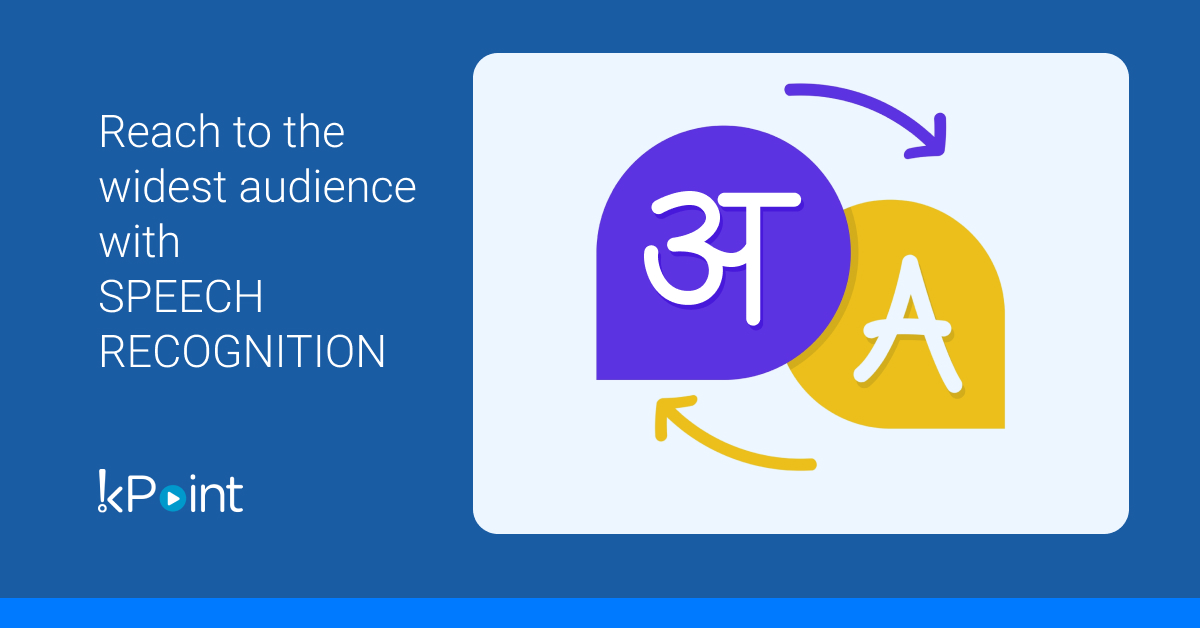
Over 6500 languages are spoken globally every day, and this has a profound impact on online video consumption. During the early days of the internet, in the 1990s, almost 80% of internet users comprised an English-speaking audience – but that is no longer the case. In 2020, only a quarter of online content was consumed in English. Half was dominated by nine other main languages, and approximately a quarter was made up of all the other diverse languages in the world.
This means that when you create videos accessible only to an English-speaking audience, you significantly limit your reach and engagement. That’s why at kPoint, we offer advanced multilingual video transcription capabilities that let you create videos in any language you choose, and allow the audience to consume videos in a language they choose.
Why Do You Need Multilingual Transcription for Enterprise Video?
Whether you’re creating videos for internal consumption (like learning content, onboarding videos, etc.), or using the medium to reach out to an external customer base, multilingual transcription is a must-have. This is because it helps you:
- Support a diverse workforce and drive inclusivity – Workforces around the world are now increasingly diverse due to globalization, the rise of the gig economy, and the now the option to WFH. Companies must be inclusive when creating internal content so that they can engage with employees from different cultural backgrounds.
- Expand your audience reach beyond local customers – Multilingual transcriptions open up huge possibilities for scaling your business. In addition to connecting with local customers in your regional language, you can create video ads, product explainers, video testimonials, etc. that can be understood by a local audience.
- Increase video accessibility for hearing-impaired viewers – Multilingual transcriptions can be helpful for those who understand your native language but are hearing-impaired. In such scenarios, auto-generated transcriptions allow viewers to follow the content regardless of their ability to listen to the audio stream – and this is essential for diversity & inclusion as well.
- Rank higher in terms of SEO optimization – Google has always ranked websites and videos with accessibility features higher than their non-accessible counterparts. Also, generating a transcript means that there is more room for marketers to enable search engine optimization (SEO) and ensure the content is perfectly tweaked for a higher ranking.
- Accommodate video consumption in a non-ideal environment – This is an extremely common use case for viewers in every demographic. Transcriptions allow your audience to consume video even when the surrounding ambient noise isn’t ideal – for example, during commutes, where there is an impromptu meeting in the next cubicle, or when a family member is vacuuming as you WFH. Without transcriptions, the viewer is likely to pause, disengage, and even abandon the video-watching experience altogether.
- Make it easier for users to search in their language – Multilingual transcriptions make videos searchable in languages other than the one in which it was created. Using intelligent search, you can make the entire transcription (in a variety of languages) searchable to viewers. This is particularly helpful for internal audiences such as corporate learners, as they can quickly look up content when it is most relevant to them.
Using Intelligent Speech Recognition Technology for Multilingual Transcription
While it is possible to manually create transcriptions for videos, it is a time-consuming process and you will likely stay limited to just one or two languages. Intelligent speech recognition (a subset of AI) automates this by converting uttered sounds into natural language text.
It then applies a translation algorithm to convert the transcription into one or more languages of your choice. kPoint uses a combination of three techniques to index content and create transcriptions from a video. Intelligent speech recognition helps to recognize each word, object detection and optical character recognition helps to recognize text inside video images, and slide content ingestion retains the text from presentations you convert into a video format. This allows us to not only deliver multilingual transcriptions that help achieve all of the benefits we discussed, but also enhance searchability and SEO ranking dramatically.
Discover kPoint: A Video Management Platform with Automated and Manual Transcription Tools
With kPoint, you can break language barriers and increase audience engagement using a next-gen video management platform. There are two ways you can add transcripts, and each has its own benefits:
- Automated speech-to-text – The platform’s automatic speech-to-text conversion feature generates transcripts in multiple languages like English (Indian), Hindi, Tamil, Telugu, etc. The video owner can choose which ones to display to the viewer. This option is extremely time and effort-efficient.
- SRT file upload – You can upload an SRT file containing the transcript by referring to one of our samples. This requires more effort, but you can tweak the language, make changes, and optimize for SEO. kPoint also gives you the ability to download an auto-generated transcript and finetune it manually.
As video becomes the preferred medium for content consumption in both our personal and professional lives, transcriptions are a must-have capability. For non-native English speakers, hearing-impaired audiences, and the average employee/customer stuck in a noisy environment, multilingual transcripts massively improve the video watching experience. And, thanks to cutting-edge AI-enabled video management platforms, you don’t need to spend hours creating an accurate and SEO-optimized transcription for your video content.
To learn more about these benefits and how intelligent speech recognition can help, contact us.

